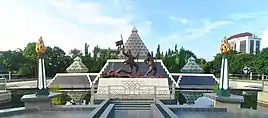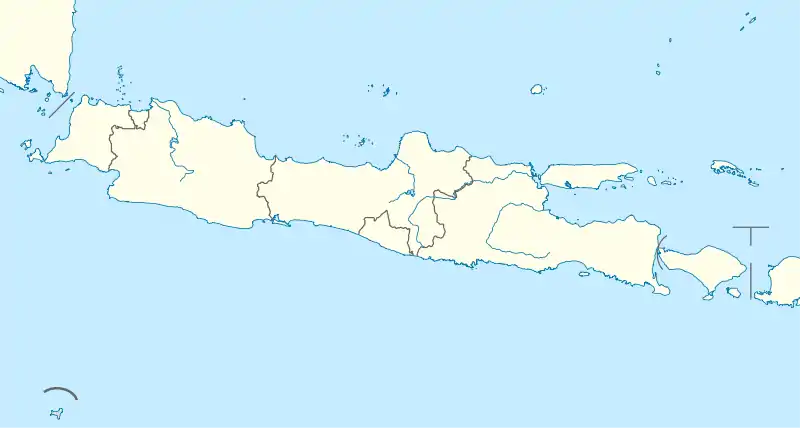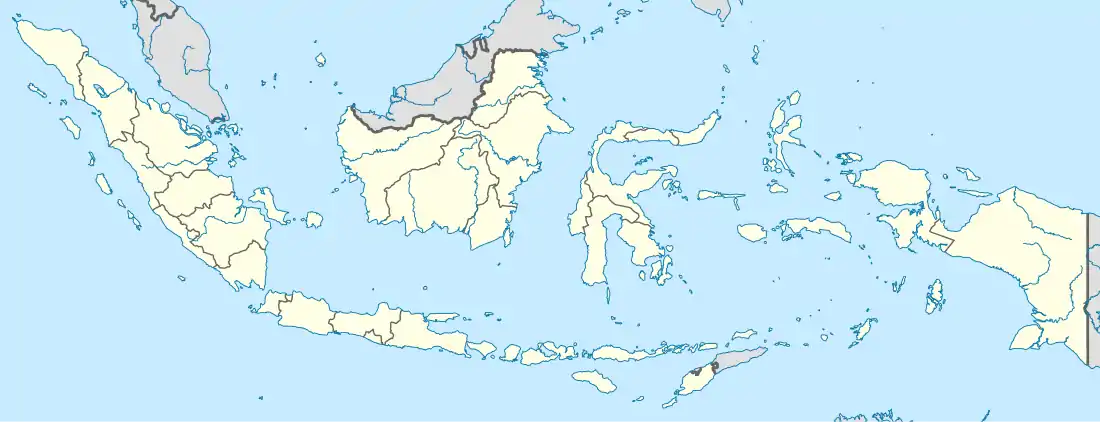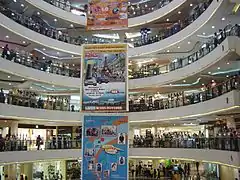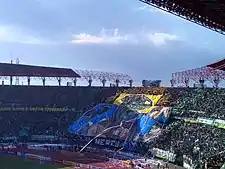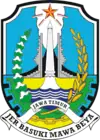Surabaya
Surabaya (Indonesian pronunciation: [suraˈbaja] (![]() listen); older spelling: Soerabaja) is the capital of the Indonesian province of East Java and the second-largest city in Indonesia after Jakarta. Located on northeastern border of Java island, on the Madura Strait, it is one of the earliest port cities in Southeast Asia. According to the National Development Planning Agency, Surabaya is one of the four main central cities of Indonesia, alongside Jakarta, Medan, and Makassar.[10][11]The city has a population of 2.89 million within its city limits in 2019 and 9.5 million in the extended Surabaya metropolitan area, making it the second-largest metropolitan area in Indonesia.[4]
listen); older spelling: Soerabaja) is the capital of the Indonesian province of East Java and the second-largest city in Indonesia after Jakarta. Located on northeastern border of Java island, on the Madura Strait, it is one of the earliest port cities in Southeast Asia. According to the National Development Planning Agency, Surabaya is one of the four main central cities of Indonesia, alongside Jakarta, Medan, and Makassar.[10][11]The city has a population of 2.89 million within its city limits in 2019 and 9.5 million in the extended Surabaya metropolitan area, making it the second-largest metropolitan area in Indonesia.[4]
Surabaya | |
|---|---|
| Regional transcription(s) | |
| • Javanese | ꦯꦸꦫꦧꦪ |
From top, left to right: Downtown Central Surabaya, Suramadu Bridge at night, Jalesveva Jayamahe Monument, Museum 10 November | |
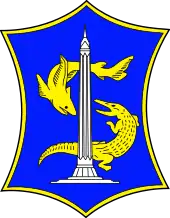 Coat of arms | |
| Nickname(s): Kota Pahlawan (City of Heroes) | |
| Motto(s): Sparkling Surabaya | |
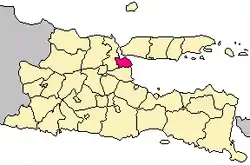 Location within East Java | |
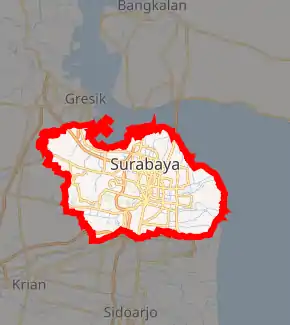
Interactive map outlining Surabaya | |
| Coordinates: 07°14′45″S 112°44′16″E | |
| Country | |
| Region | Java |
| Province | |
| Settled | 1037[1] |
| Founded | 31 May 1293[2] |
| Incorporated | 1 April 1906[3] |
| Government | |
| • Mayor (Wali Kota) | Whisnu Sakti Buana(acting) |
| • Vice Mayor | Vacant |
| Area | |
| • City | 350.5 km2 (135.3 sq mi) |
| • Urban | 911 km2 (352 sq mi) |
| • Metro | 5,925 km2 (2,288 sq mi) |
| Elevation | 5 m (16 ft) |
| Population (2019 estimated[4]) | |
| • City | 2,898,240 (2nd) |
| • Density | 8,268/km2 (21,410/sq mi) |
| • Urban | 6,499,000 (3rd) |
| • Urban density | 7,134/km2 (18,480/sq mi) |
| • Metro | 9,570,870 (2nd) |
| • Metro density | 1,615/km2 (4,180/sq mi) |
| Demographics | |
| • Ethnic groups | Javanese, Madurese, Sundanese, Minangkabau, Batak, Banjar, Balinese, Bugis, Malay, Chinese, Indian, Arabs |
| • Religion[7] | Islam 80.13% Christianity: — Protestantism 9.12% — Catholicism 8.98% Buddhism 1.49% Hinduism 0.26% Confucianism 0.01% |
| Time zone | UTC+07:00 |
| Postal Code | 60xxx, 61xxx |
| Area code | (+62) 31 |
| Vehicle registration | L (for Motor vehicle), SKB (for Rickshaw) |
| Nominal GDP[8] | 2019 |
| - Total | Rp 580.7 trillion (2nd) $ 41.1 billion $ 135.0 billion (PPP) |
| - Per capita | Rp 200,505 thousand (5th) $ 14,180 $ 46,610 (PPP) |
| - Growth | |
| HDI (2019) | 0.822[9] (10th) – Very High |
| Airport | Juanda International Airport |
| Commuter Rail | Susi Commuter DMU, Sulam Commuter DMU, Jenggala DMU, KA Lokal Bojonegoro DMU, Kertosono Local Train, Arek Surokerto DMU |
| Rapid Transit | Surabaya LRT and MRT (planned) |
| Website | surabaya.go.id |
The city was settled in 10th century by the Kingdom of Janggala, one of the two Javanese kingdoms that was formed in 1045 when Airlangga abdicated his throne in favor of his two sons. In the late 15th and 16th centuries, Surabaya grew to be a duchy, a major political and military power as well as a port in eastern Java, probably under Majapahit empire.[12] At that time, Surabaya was already a major trading port, owing to its location on the River Brantas delta and the trade route between Malacca and the Spice Islands via the Java Sea. During the decline of Majapahit, the lord of Surabaya resisted the rise of the Demak Sultanate and only submitted to its rule in 1530.[13][14] Surabaya became independent after the death of Sultan Trenggana of Demak in 1546.[15][16]
From the 18th century until the mid-20th century, Surabaya was the largest city in the Dutch East Indies, and the center of trading in the Indonesian archipelago, which was then a competitor to Shanghai and Hong Kong.[12] The city is known as Kota Pahlawan (the city of heroes) due to the importance of the Battle of Surabaya during the Indonesian National Revolution. The city is one of the important financial, commercial, industrial, transportation, and entertainment hub of the archipelago,[17] arguably second only to Jakarta, and the Port of Tanjung Perak is Indonesia's second-busiest seaport located on northern Surabaya. The city is also known for being one of the cleanest and greenest in Indonesia.
Etymology
.svg.png.webp)
Surabaya from the Javanese "sura ing baya", means "bravely facing danger";[18] originally from the union of Sanskrit words the "surya" or sun and the "bhaya" or fear. Surabaya alludes to a prophecy of Jayabaya [meaning "conquering the fear", from the Sanskrit words "Jaya" or "Vijaya" (victory or conqueror) and "bhaya" (fear)], a 12th-century psychic king of Kediri Kingdom, foreseeing a fight between a giant white shark and a giant white crocodile taking place in the area.[19] The event is sometimes interpreted as foretelling the Mongol invasion of Java, a major conflict between the forces of Kublai Khan, Mongol ruler of China, and those of Raden Wijaya's Majapahit on 31 May 1293,[20][18] which is now considered the date of the city's founding.[21] The two animals are now used as the city's symbol, with the two facing and circling each other, as depicted in a statue appropriately located near the entrance to the city zoo.[22]
Some people consider Jayabaya's prophecy as being about the great war between native Surabayan people and foreign invaders at the start of the war of independence in 1945. Another story tells of two heroes who fought each other to be the king of the city. The two heroes were named Sura and Baya. These folk etymologies, though embraced enthusiastically by its people and city leaders, are unverifiable.[23]

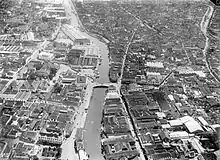
History
Early history
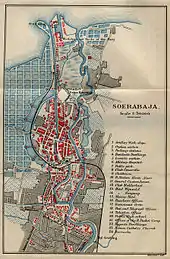
The Kingdom of Janggala was one of the two Javanese kingdoms that was formed in 1045 when Airlangga abdicated his throne in favor of his two sons. The earliest historical record of Surabaya was in the 1225 book Zhu fan zhi written by Zhao Rugua, in which it was called Jung-ya-lu.[24] The name Janggala was probably originated from the name "Hujung Galuh" (Old Javanese lit: "Cape Diamond" or "Cape Gemstone"), or "Jung-ya-lu" according to Chinese source. Hujung Galuh was located on the estuarine of Brantas River and today is the part of modern Surabaya city and Sidoarjo Regency.[25] By the 14th to 15th centuries, Surabaya seems to be one of the Majapahit ports or coastal settlements, together with Tuban, Gresik, and Hujung Galuh (Sidoarjo). Ma Huan documented the early 15th-century visit of Zheng He's treasure ships in his 1433 book Yingya Shenglan: "after travelling south for more than 20 li, the ship reached Sulumayi, whose foreign name is Surabaya. At the estuary, the outflowing water is fresh".[26]Tomé Pires mentioned that a Muslim lord was in power in Surabaya in 1513, though likely still a vassal of the Majapahit.
Ma Huan visited Java during Zheng He's fourth expedition in 1413, during the reign of Majapahit king Wikramawardhana. He describes his travel to the Majapahit capital. He first arrived at the port of Tu-pan (Tuban) where he saw large numbers of Chinese settlers migrated from Guangdong and Chou Chang. Then, he sailed east to thriving new trading town of Ko-erh-hsi (Gresik), Su-pa-erh-ya (Surabaya), and then sailing inland into the river by smaller boat to the southwest until reached the Brantas river port of Chang-ku (Changgu). Continuing to travel by land to the southwest, he arrived in Man-che-po-I (Majapahit), where the Javanese king stayed.[27]
Pre-colonial era
By the late 15th century, Islam began to take its root in Surabaya. The settlement of Ampel Denta, located around Ampel Mosque in today Ampel subdistrict, Semampir district, north Surabaya, was established by a charismatic Islamic proselytiser Sunan Ampel.[28]
In the late 15th and 16th centuries, Surabaya grew to be a duchy, a major political and military power in eastern Java. The Portuguese writer Tomé Pires mentioned that a Muslim lord was in power in Surabaya in 1513, though likely still a vassal of the Hindu–Buddhist Majapahit.[13] At that time, Surabaya was already a major trading port,[29] owing to its location on the River Brantas delta and the trade route between Malacca and the Spice Islands via the Java Sea.[30] During the decline of Majapahit, the lord of Surabaya resisted the rise of the Demak Sultanate and only submitted to its rule in 1530.[13][14] Surabaya became independent after the death of Sultan Trenggana of Demak in 1546.[15][16]
The Duchy of Surabaya entered a conflict with and was later captured by the more powerful Sultanate of Mataram in 1625 under Sultan Agung.[31]:31 It was one of Mataram's fiercest campaigns, in which they had to conquer Surabaya's allies, Sukadana and Madura, and to lay siege to the city before capturing it. With this conquest, Mataram then controlled almost the whole of Java, except the Sultanate of Banten and the Dutch settlement of Batavia.[31]:31
Colonial era
The expanding Dutch East India Company took the city over from a weakened Mataram in November 1743. In consolidating its rule over Surabaya, and in time, the rest of East Java, the Dutch collaborated with leading regional magnates, including Ngabehi Soero Pernollo (1720–1776), his brother Han Bwee Kong, Kapitein der Chinezen (1727–1778), and the latter's son, Han Chan Piet, Majoor der Chinezen (1759–1827), all from the powerful Han family of Lasem.[32][33]
In the 18th and 19th centuries, Surabaya was the largest city in the Dutch East Indies. It became a major trading center under the Dutch colonial government and hosted the most extensive naval base in the colony. Surabaya was also the largest city in the colony serving as the center of Java's plantation economy, industry and was supported by its natural harbor.[34] In 1920, a census recorded that Batavia had become the largest city. In 1917, a revolt occurred among the soldiers and sailors of Surabaya, led by the Indies Social Democratic Association. The revolt was firmly crushed, and the insurgents were given harsh sentences.[35]
Independence era
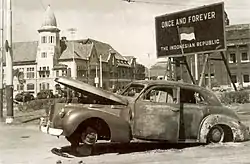
Japan occupied the city in 1942, as part of the Japanese occupation of the Dutch East Indies, and it was bombed by the Allies in 1944. After the surrender of Japan at the end of World War II, Surabaya was seized by Indonesian nationalists. The young nation soon came into conflict with the British, who had become caretakers of the Dutch colony after the Japanese surrender.[36]
The Battle of Surabaya, one of the well-known battles of the Indonesian revolution, started after the Arek-Arek Suroboyo (Teenagers of Surabaya) assassinated the British Brigadier Mallaby on 30 October 1945, near Jembatan Merah (the "Red Bridge"), allegedly with a stray bullet. The Allies gave an ultimatum to the Republicans inside the city to surrender, but they refused. The ensuing battle, which cost thousands of lives, took place on 10 November, which Indonesians subsequently celebrate as Hari Pahlawan (Heroes' Day). The incident of the red-white flag (the Dutch flag at the top of Yamato Hotel's tower that was torn into the Indonesian red-white flag) by Bung Tomo is also recorded as a heroic feat during the struggle of this city.[37]
The city is known as Kota Pahlawan (the city of heroes) due to the importance of the Battle of Surabaya in galvanising Indonesian and international support for Indonesian independence during the Indonesian National Revolution.[38]
Modern history
In June 2011, Surabaya received the Adipura Kencana Award as number one among 20 cities in Indonesia. Surabaya was reported by a Singaporean as being clean and green.[39]
The first confirmed case of COVID-19 in East Java was in Surabaya, on 17 March 2020.[40] In May 2020, Surabaya became epicenter of the pandemic in Indonesia.
Geography
Topography
.jpg.webp)
Surabaya is located on the northern coast of East Java province. It is mostly lowlands with a river estuary of Kalimas, one of two branches of the Brantas River. Surabaya city borders Madura Strait in the north and east, Sidoarjo Regency in the south, and Gresik Regency in the west. The regencies surrounding Surabaya are:
- Lamongan Regency to the northwest
- Gresik Regency to the west
- Bangkalan Regency to the northeast (on Madura island)
- Sidoarjo Regency to the south
- Mojokerto Regency to the southwest
Like many other large Indonesian metropolises, many residents reside outside the city limits in a metropolitan area called Gerbangkertosusila.
Cityscapes
.jpg.webp)

.jpg.webp)
Climate
Under the Köppen climate classification system, Surabaya features a tropical wet and dry climate (Aw), with distinct wet and dry seasons. The city's wet season runs from October through May, while the dry season covers the remaining four months. Unlike many cities and regions with a tropical wet and dry climate, average high and low temperatures are very consistent throughout the year, with an average high temperature of around 31 °C and average low temperatures around 23 °C.
| Climate data for Surabaya, elevation: 5 m or 16 ft, extremes 1963–1980 | |||||||||||||
|---|---|---|---|---|---|---|---|---|---|---|---|---|---|
| Month | Jan | Feb | Mar | Apr | May | Jun | Jul | Aug | Sep | Oct | Nov | Dec | Year |
| Record high °C (°F) | 33.3 (91.9) |
34.4 (93.9) |
33.9 (93.0) |
33.3 (91.9) |
33.9 (93.0) |
33.9 (93.0) |
33.9 (93.0) |
34.4 (93.9) |
33.9 (93.0) |
35 (95) |
35.6 (96.1) |
35 (95) |
35.6 (96.1) |
| Average high °C (°F) | 31.8 (89.2) |
31.5 (88.7) |
31.6 (88.9) |
31.4 (88.5) |
31.6 (88.9) |
31.2 (88.2) |
31.3 (88.3) |
30.1 (86.2) |
32.7 (90.9) |
33.4 (92.1) |
33.1 (91.6) |
31.9 (89.4) |
31.8 (89.2) |
| Daily mean °C (°F) | 26.8 (80.2) |
26.8 (80.2) |
27 (81) |
27.3 (81.1) |
27.3 (81.1) |
26.7 (80.1) |
26.2 (79.2) |
26.5 (79.7) |
27.2 (81.0) |
28.2 (82.8) |
28.3 (82.9) |
27.3 (81.1) |
27.1 (80.9) |
| Average low °C (°F) | 24.1 (75.4) |
24.2 (75.6) |
24.0 (75.2) |
24.8 (76.6) |
24.1 (75.4) |
23.5 (74.3) |
23.0 (73.4) |
22.5 (72.5) |
22.9 (73.2) |
23.7 (74.7) |
24.1 (75.4) |
23.8 (74.8) |
23.7 (74.7) |
| Record low °C (°F) | 21.1 (70.0) |
21.1 (70.0) |
20.6 (69.1) |
18.3 (64.9) |
16.7 (62.1) |
15.6 (60.1) |
14.4 (57.9) |
16.1 (61.0) |
16.7 (62.1) |
17.8 (64.0) |
19.4 (66.9) |
20 (68) |
14.4 (57.9) |
| Average rainfall mm (inches) | 327 (12.9) |
275 (10.8) |
283 (11.1) |
181 (7.1) |
159 (6.3) |
47 (1.9) |
17 (0.7) |
15 (0.6) |
22 (0.9) |
101 (4.0) |
105 (4.1) |
219 (8.6) |
1,751 (69) |
| Average rainy days | 17 | 18 | 19 | 15 | 13 | 7 | 5 | 3 | 4 | 11 | 12 | 23 | 147 |
| Average relative humidity (%) | 66.61 | 69.1 | 66.3 | 67.23 | 64.87 | 60.27 | 60.84 | 57.87 | 54.53 | 56.06 | 56.13 | 63.03 | 61.90 |
| Mean monthly sunshine hours | 140.6 | 123.6 | 143.2 | 155.8 | 188.9 | 199.3 | 223.8 | 245.5 | 228.8 | 221.0 | 182.6 | 138.1 | 2,191.2 |
| Source 1: World Meteorological Organization;[41] Climate-Data.org (daily mean);[42] and Worldwide Bioclimatic Classification System (record extreme temperature)[43][44] | |||||||||||||
| Source 2: WeatherOnline (2000–2019 sunshine data)[45] | |||||||||||||
| Wind Speed and Humidity data for Surabaya | |||||||||||||
|---|---|---|---|---|---|---|---|---|---|---|---|---|---|
| Month | Jan | Feb | Mar | Apr | May | Jun | Jul | Aug | Sep | Oct | Nov | Dec | Year |
| Maximum Wind Speed (km/h) | 23 | 16 | 16 | 26 | 27 | 29 | 40 | 34 | 34 | 35 | 29 | 21 | 27.5 |
| Average Wind Speed (km/h) | 13.39 | 12.10 | 13.30 | 14.37 | 20.26 | 16.87 | 22.71 | 22.16 | 22.8 | 22.35 | 18.6 | 13.55 | 17.71 |
| Minimum Wind Speed (km/h) | 8 | 10 | 10 | 10 | 3 | 5 | 11 | 11 | 14 | 10 | 11 | 10 | 9.42 |
| Maximum Humidity (%) | 86 | 75 | 83 | 92 | 96 | 77 | 67 | 69 | 64 | 73 | 65 | 79 | 77.17 |
| Average Humidity (%) | 66.61 | 69.1 | 66.3 | 67.23 | 64.87 | 60.27 | 60.84 | 57.87 | 54.53 | 56.06 | 56.13 | 63.03 | 61.9 |
| Minimum Humidity (%) | 44 | 60 | 59 | 58 | 53 | 47 | 52 | 47 | 46 | 42 | 46 | 53 | 50.58 |
| Source: Climatevo[46] | |||||||||||||
| Climate data for Surabaya | |||||||||||||
|---|---|---|---|---|---|---|---|---|---|---|---|---|---|
| Month | Jan | Feb | Mar | Apr | May | Jun | Jul | Aug | Sep | Oct | Nov | Dec | Year |
| Average sea temperature °C (°F) | 29.3 (84.7) |
28.9 (84.0) |
29.4 (84.9) |
29.6 (85.3) |
29.5 (85.1) |
29.0 (84.2) |
28.3 (82.9) |
27.8 (82.0) |
28.1 (82.6) |
28.9 (84.0) |
30.1 (86.2) |
30.2 (86.4) |
29.1 (84.4) |
| Mean daily daylight hours | 12.5 | 12.3 | 12.1 | 11.9 | 11.8 | 11.7 | 11.7 | 11.9 | 12.1 | 12.3 | 12.5 | 12.5 | 12.1 |
| Average Ultraviolet index | 12 | 12 | 12 | 12 | 11 | 10 | 10 | 12 | 12 | 12 | 12 | 12 | 11.6 |
| Source: Weather Atlas[47] | |||||||||||||
Urban forest and parks
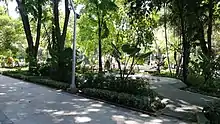
Surabaya is one of the cleanest and greenest cities in Indonesia.[48] This can be seen by the urban parks in almost every neighborhood area which is equipped with fountains.[49] These parks include Bungkul Park, Harmoni Park, Pelangi Park, Surya Park, Mundu Park, Undaan Fruit Park, Jayengrono Park,[50] and others. Bungkul Park was awarded the Asian Townscape Award 2013 from the United Nations as the best park in Asia because of its very complete and integrated facilities, starting from the economic area (street food centers), green open area, parks, disability-friendly area, free internet (Wi-Fi), and routine garden maintenance management.[51] [52] The city of Surabaya is very clean and is ranked 3rd in the world[53] This city has won first place with the most favorite city that workers are looking for The city of Surabaya is very outstanding in the field of environment.[54] The city has won many awards in the field of environment and city planning both nationally and internationally.[55] These awards included Adipura, Adipura kencana, Adiwiyata, Wahyu Tata Nugraha, and other green awards. The Adipura Cup, which Surabaya won several times in the 1980s and 1990s, the Adipura Kencana trophy, the cleanest metropolitan city category in the 1990s and in the period of 2010 to 2017, seven consecutive times, as well as the Adipura trophy, plenary in 2016.[56] The city also received several awards from the central government as one of the major cities with the best air quality in Indonesia.[57] Surabaya in 2012 has won the award "City of the Best Participation in the Asia Pacific" by Citynet for the success of the city government and people's participation in managing the environment. Surabaya has also been awarded the ASEAN Environmentally Sustainable City Award or "the city with the best sustainable environmental management in ASEAN" in 2011 and 2014.[58] In 2018, Surabaya won the Lee Kuan Yew City Prize along with Hamburg, Kazan, and Tokyo, on the basis of the ability to maintain and manage villages in the middle of the city with excellent government management and community participation amid the rapidly developing city.[59] Surabaya became the first city in Indonesia to receive this award.[59][60] On the other hand, however, there are not a few areas in Surabaya that appear less organised, especially in the neighborhoods of Southern and Northern Surabaya.[61][62] This is the concern of the city government to reorganise the environment of the region.[63]
Government

The city has its own local government and legislative body. The mayor and members of representatives are locally elected by popular vote for a five-year term. The city government enjoys greater decentralisation of affairs than the provincial body, such as the provision of public schools, public health facilities, and public transportation. The current mayor of the city is Tri Rismaharini, the city's first female mayor, and has led Surabaya to achieve many regional, national and international awards since her first term began in 2010. In 2012, Surabaya was awarded the "ASEAN Environmentally Sustainable City Award". Besides Mayor and Vice Mayor, there is Surabaya Municipal People's Representative Council, which is a legislative body of 50 council members directly elected by the people in legislative elections every five years.[64]
The city administration maintains a central command center since 2016, integrating all civic services including Satpol PP, Bakesbangpol and Linmas, Hygiene and Parks Service, Transportation Agency, Public Works Agency of Highways and Extermination, ambulance and fire services.[65][66] All services can be accessed by dialling 112 number. The city is dubbed as the champion of a smart city in Indonesia and won Indonesia Smart City Index (IKCI) in 2015 and 2018.[67] The City of Heroes also received an award at the Guangzhou International Award for Urban Innovation in the Online Popular City category and Lee Kuan Yew World City Prize in 2018.[68]
Surabaya is divided into 31 kecamatan (districts),[69][70] and 161 kelurahan (subdistricts). The districts are grouped into five areas: Central, North, South, East, and West. The districts are:
|
|
|
Demographics
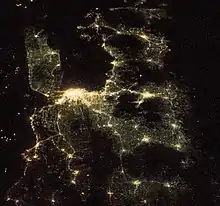
| Year | Pop. | ±% |
|---|---|---|
| 1883 | 122,000 | — |
| 1897 | 142,980 | +17.2% |
| 1900 | 150,000 | +4.9% |
| 1930 | 341,700 | +127.8% |
| 1940 | 403,000 | +17.9% |
| 1945 | 618,000 | +53.3% |
| 1949 | 500,000 | −19.1% |
| 1950 | 715,000 | +43.0% |
| 1955 | 808,267 | +13.0% |
| 1961 | 1,008,000 | +24.7% |
| 1965 | 1,183,851 | +17.4% |
| 1971 | 1,556,255 | +31.5% |
| 1980 | 2,008,335 | +29.0% |
| 1990 | 2,467,089 | +22.8% |
| 2000 | 2,610,519 | +5.8% |
| 2010 | 2,768,225 | +6.0% |
| 2015 | 3,457,409 | +24.9% |
| Source: Various sources
1883–1961 : Surabaya: City of Work[71] | ||
Surabaya is the second-most populous city in Indonesia, with 3,457,409 recorded in the chartered city limits (kota) in the 2015 census.[75] With the extended metropolitan development area called Gerbangkertosusila (derived from Gresik-Bangkalan-Mojokerto-Surabaya-Sidoarjo-Lamongan) adding more than 12 million inhabitants in several cities and around 50 districts spread over noncontiguous urban areas including Gresik, Sidoarjo, Mojokerto, and Pasuruan regencies. The central government of Indonesia recognises only the metropolitan area (Surabaya, Gresik, and Sidarjo) as Greater Surabaya (Zona Surabaya Raya) with a population of 8,319,229 (2015), making Surabaya now the second-largest metropolitan area in Indonesia.[76] The city is highly urbanised, with industries centralised in the city, and contains slums. As a leading education center, the city is also home for students from around Indonesia.[77]
Surabaya is an old city that has expanded over time, and its population continues to grow at roughly 2.2% per year. In recent years, more people have moved to Surabaya from nearby suburbs and villages in East Java.[78]
Ethnicity
Javanese people form the majority in Surabaya while the Madurese are significant minorities.[79] Surabaya also has ethnic populations from other parts of Indonesia: Sundanese, Minang, Batak, Banjar, Balinese, and Bugis. Surabaya is one of the major cities in Indonesia that has a significant population of Chinese, Indian and Middle East people; there are Arabs, especially the Hadhrami people that originate from the Hadhramaut region in Yemen, Armenian people, and Jews.[80]
Language
Most citizens speak a dialect of East Javanese called Suroboyoan, a subdialect of the Arekan dialect. A stereotype of this dialect concerns equality and directness in speech.[81] The use of register is less strict than the Central Java dialect.[82] The Suroboyoan dialect is a mixture of both Indonesian and Javanese, also with some significant influence from foreign languages such as Madurese, which has formed a distinctive dialect known as Suroboyoan. The Suroboyoan dialect is actively promoted in local media, such as in local TV shows, radio, newspapers, and traditional dramas called Ludruk.[83]
Religion
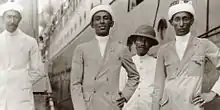
Although around 80% of citizens in Surabaya adhere to Sunni Islam, other major religions include Christianity (Roman Catholicism, Protestantism, and Orthodox), of whom the majority are Roman Catholics. The influence of Hinduism is strong in basic Surabayan culture, but only a minority of the population adheres to Hinduism mostly among the ethnic Indian minority.[85] Also, a significant population of Chinese Indonesians adhere to Buddhism and Confucianism, and a small community of Dutch Jews follow Judaism.[86]
The city had an influential role as a major Islamic center in Java during the Wali Sanga era.[87] The prominent and honored Islamic figure in Surabaya was Sunan Ampel (Raden Rahmat).[87] His tomb is a sacred religious site in the city and is visited by Surabayans and pilgrims from different parts of Indonesia. The largest Muslim organisation in Indonesia, Nahdlatul Ulama, was established in Surabaya on 26 January 1926.[88] Al-Akbar Mosque is the largest mosque in the city and one of the largest mosque in the world.[89]
Christianity as a whole is mainly practised by Chinese Indonesians, as well as native Javanese, Bataks, and Ambonese who attend either a Roman Catholic or Protestant church.[90][91] A minority of Javanese practice at the Gereja Kejawen,[92] a branch of native Christianity. Around 15 churches are in Surabaya; they vary in size. The Church of the Birth of Our Lady, also known as Gereja Kepanjen, was built in 1815 as the first church in Surabaya and is one of the oldest churches in Indonesia.[93] The main Orthodox Church in Indonesia, St Nikolas Church, is also based in Surabaya. The Orthodox Christian Center Surabaya was opened on 15 October 2008.[94]
Once the major religion in Surabaya and across the archipelago during the Janggala and Majapahit era, Hinduism played a major role in traditional Surabayan culture.[95] Small Hindu communities still exist, most commonly in the eastern sections of the city.[96] Surabaya was the location of the only synagogue in Java,[97] but it rarely obtained a minyan (quorum). The synagogue was demolished in 2013 by unidentified persons while the city council was in the process of registering it as a heritage site.[98] In the years before its demolition, it had been the site of many anti-Israel protests.[98] A Jewish cemetery exists in the city.[99][100]
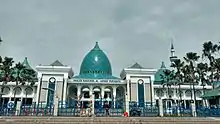
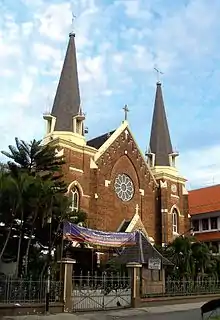 Church of the Birth of Our Lady, oldest church in Surabaya
Church of the Birth of Our Lady, oldest church in Surabaya An Eastern Orthodox Church congregation
An Eastern Orthodox Church congregation%252C_Surabaya.jpg.webp) Tian Ti Pagoda, an iconic Buddhist temple
Tian Ti Pagoda, an iconic Buddhist temple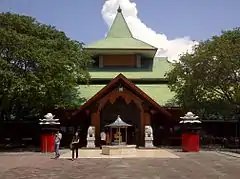 Sanggar Agung, a Chinese folk temple
Sanggar Agung, a Chinese folk temple Pura Jagatnatha Perak, a Hindu temple
Pura Jagatnatha Perak, a Hindu temple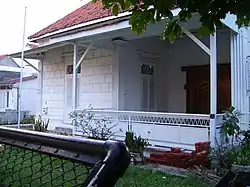 Jewish Surabaya Synagogue
Jewish Surabaya Synagogue
Culture
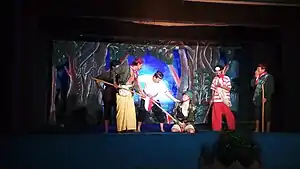
Javanese culture in Surabaya has distinctive characteristics compared to other regions, the uniqueness of its characteristics which is more egalitarian and open. Surabaya is known to have several distinctive arts, namely:
- Ludruk, a cultural drama performance art that tells daily routine of working-class people.[101]
- Remo Dance, a traditional welcome dance that is generally dedicated to special guests.[102]
- Kidungan, a poetry musicalisation and contains elements of humor.
In addition to the art above, the call culture of arek or rek (a distinctive call from Surabaya) is also a unique characteristic. There are other distinctive calls as well, namely Cak for men and Ning for women. In an effort to preserve culture, Cak & Ning Surabaya is selected once a year, and the selected finalists are tourism ambassadors and icons of the young generation of the city.[103]
Cak Durasim Festival (FCD) is held annually, which is an art festival to preserve the culture of Surabaya and East Java in general. The Cak Durasim Festival is usually held at Cak Durasim Building.[104] There is also the Surabaya Art Festival (FSS) which raises all kinds of art forms such as theatre, dance, music, literary seminars, painting exhibitions. Event organisers usually aside from art groups in Surabaya also come from outside the city. Also enlivened is the screening of movie screens and T-shirt exhibitions. The Surabaya Art Festival is held once a year in June and is usually held at the Youth Hall.
In addition to Javanese culture, there has also been a mixture of various cultures such as from Madura, the Arab world, India, the Malay world, China and Europe. The Surabaya Cross Culture is an annual art and culture festival that show various cultures outside Indonesia.[105]
Economy
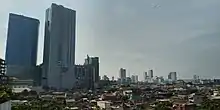
.jpg.webp)
Since the early 1900s, Surabaya has been one of the most important and busiest trading city ports in Asia.[106] Principal exports from the port include sugar, tobacco, and coffee.[107] Its rich history as a trading port has led to a strong financial infrastructure with modern economic institutions such as banks, insurance, and sound export-import companies. The economy is influenced by the recent growth in international industries and the completion of the Suramadu Bridge. The high potential and economic activities make the city an attractive destination to foreign investors. The city is home to a large shipyard and numerous specialised naval schools.[108] The Bank of Indonesia has also made plans for Surabaya to be the Islamic financial center of Indonesia.[109][110]
Business
As the provincial capital, Surabaya has numerous offices and business centers; as a metropolitan city, it became the center of economic, financial, and business activities in East Java and beyond. Also, Surabaya is the second-largest port city in Indonesia after Jakarta. As a trading center, Surabaya is not only a trade center for East Java, but also facilitates areas in Central Java, Kalimantan, and Eastern Indonesia. Surabaya's strategic location in almost in the center of Indonesia and just south of Asia makes it one of the critical hubs for trading activities in Southeast Asia.[111] It is currently in the process of building high-rise skyscrapers, including apartments, condominiums, and hotels to attract foreign capital. Surabaya and the surrounding area are undergoing the most rapidly growing and the most advanced economic development in Indonesia. The city is also one of the most essential cities in supporting Indonesia's economy.
Most of the population is engaged in services, industry, and trade. Surabaya is a fast-growing trading center. Major industries include shipbuilding, heavy equipment, food processing and agriculture, electronics, home furnishings, and handicrafts. Many major multinational companies are based in Surabaya, such as Sampoerna, Maspion, Wings Group, Unilever Indonesia, Pakuwon Group, Jawa Pos Group, and PAL Indonesia.[112][113]
Business districts
The area between Jalan Basuki Rachmat, Jalan Tunjungan,[114] Jalan Embong Malang, and Jalan Bubutan has grown as a business center and has turned into one of the main business and trade activities areas in Surabaya. Some of the important buildings in this area include Wisma BRI Surabaya, Hotel Bumi Surabaya, Wisma Dharmala Surabaya, The Peak Residence, and Sheraton Hotel.[115][116]
Another cluster around Jalan Mayjend Sungkono, Jalan Adityawarman, Jalan HR Muhammad, and Jalan Bukit Darmo has grown as a new business center of the city. This area has now grown as one of the most rapidly growing commercial and business centers in East Java, with high-rise buildings. Some of the tallest buildings in Surabaya located in this area, such as Adhiwangsa Apartment, Waterplace Residence, Puri Matahari, Beverly Park Apartment, The Via & The Vue Apartment, Ciputra World Hotel, Puncak Permai Apartment, Rich Palace Hotel.[117][118]
Retail
Surabaya has plenty of shopping centers like other major cities of Indonesia, ranging from traditional markets to most modern shopping malls. Outlets of local and international brands have a presence in modern shopping malls. There were about 100 hectares/one million square metres of retail space in Surabaya by the end of 2016.[119] There are many dedicated markets for electronic goods, gadgets and computer hardware.
Some important shopping malls of the city are:
- BG Junction[120]
- Ciputra World Surabaya
- City of Tomorrow
- East Coast Center
- Galaxy Mall
- Grand City Mall[121]
- HI-Tech Mall
- ITC Surabaya
- Lenmarc
- Marvell City
- Pakuwon Mall
- Pasar Atom Mall
- Tunjungan Plaza
- Surabaya Town Square[122]
- World Trade Center Surabaya[123][124]
Infrastructure
Architecture

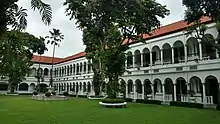
Architecture in Surabaya is a mixture of colonial, Asian, Javanese, modern, and post-modern influences. There are many colonial-era relics still standing today, such as Hotel Majapahit and Surabaya Post Office. As a relatively old city in Indonesia and Southeast Asia, most colonial buildings were built around the 17th century to the early 20th century.[125] These buildings have the influence of Dutch or European style in the Middle Ages.[126]
Before the Second World War, there were many shophouses in the old part of the city, mostly of two-storey.[127] They have the influence of European and Chinese traditions. Although some have been dismantled for new construction, there are still many old buildings that are preserved as cultural heritage and city icons, which are around the area of Kembang Jepun Street, Karet Street, Gula Street, Slompretan Street, and Rajawali Street.[128]
After the independence of Indonesia, the center of Surabaya's architectural development was concentrated only in the area of Jembatan Merah and its surroundings. In the late 1990s and early 2000s, modern and post-modern style buildings were increasingly emerging in Surabaya. Along with economic development, such buildings have continued to grow. In the 2010s, Surabaya has become a center of skyscrapers and high-rises in East Java and central regions of Indonesia, such as The Peak Residence – Tunjungan Plaza 6 (215 meters) and One Icon Residence – Tunjungan Plaza 5 (200 meters).[129]
Important landmarks
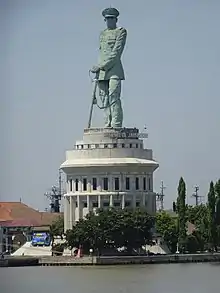
- Kebun Binatang Surabaya (Surabaya Zoo) opened in 1916. It was the first Zoo in the world to breed orangutans in captivity.
- Zheng He (Cheng Ho) Mosque, a recently built mosque, one of the unique mosques with Chinese-style architecture in Indonesia. Dedicated to the Hui Chinese diplomat, Zheng He.[130]
- Al-Akbar Mosque, the largest mosque in East Java.[131]
- Church of the Birth of Our Lady, Surabaya, one of the first churches to be built in Indonesia, and the first one ever built in East Java.[132]
- Heroes Monument, a 41 metres (135 ft) high monument, is the main symbol of Surabaya and commemorates the heroes of the revolutionary struggle. There is a museum on location as well, exhibiting reminders of the struggle for independence.[133]
- Museum Nahdlatul Ulama, the resource center of the culture and history of Nahdlatul Ulama, an independent Islamic religious.[134] organisation.
- Museum Bank Indonesia, a bank museum occupying the former De Javasche Bank built in 1904.[135]
- House of Sampoerna, a museum devoted to the history of clove cigarette (kretek) manufacturing in Indonesia, housed in Dutch colonial buildings dating to 1864.[136]
.jpg.webp) Wisma Intiland, most famous brutalist building in Surabaya.
Wisma Intiland, most famous brutalist building in Surabaya. - Jalesveva Jayamahe Monument, a large, admiral-like statue which commemorates the Indonesian Navy.
- Monkasel, abbreviated from Monumen Kapal Selam (Submarine Monument)[137] A Soviet-built Whiskey class submarine (named KRI Pasopati (410)), first launched in 1952, served in the Indonesian Navy from 1962 until decommissioned in 1990. After its decommissioning, Pasopati was dismantled and transferred to its present site in 1996. The submarine was reassembled on the current site and opened as a museum and tourist attraction in 1998.
- Kenjeran Beach, located in the eastern of Surabaya, which also housed Sanggar Agung, a Chinese temple build over the sea.[138]
- Market of the Chinese Tomb,[139] last resting place of Han Bwee Kong, Kapitein der Chinezen, magnate, mandarin and landlord in Surabaya and East Java, and patriarch of the patrician Han family of Lasem[140]
- Han Ancestral Hall,[141] a historic house that serves as a memorial temple for the ancestors of the Han family of Lasem[142][143]
- Tomb of Sunan Ampel[144]
- Bungkul Park, one of the most visited urban parks in Surabaya.[145]
- Wisma Intiland, a brutalist building in Downtown Surabaya.[146]
- Museum Pendidikan Surabaya[147]
Military establishment
The Eastern Fleet, one of two fleets in the Indonesian Navy, is headquartered in the city. Its maritime heritage is also represented in the form of KRI Pasopati Submarine Monument, a retired Russian Whiskey class submarine.[148][149]
Transportation
Transportation in Surabaya is supported by land and sea infrastructure serving local, regional, and international journeys. Air transport is located at Juanda Airport, at Sedati, Sidoarjo. Intracity transport is primarily by motor vehicles, motorcycles and taxis with limited public bus transport available. Surabaya is also a transit city between Jakarta and Bali for ground transportation. Another bus route is between Jakarta and the neighboring island of Madura. In 2018, President Joko Widodo inaugurated final segments of the Trans-Java Toll Road, fully connecting Jakarta and Surabaya with expressways.[150]
Airport
Surabaya's Juanda International Airport is a passenger and cargo airport which also serves as Surabaya's Navy Airbase, operated by the TNI-AL (Indonesian Navy) and located just outside Surabaya, on the outskirts of Sidoarjo. This airport has served Surabaya for many years and currently has two terminals, with domestic flights served from Terminal 1 and all international flights and Garuda Indonesia's domestic flights serviced from Terminal 2.
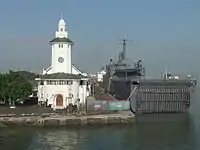
Seaport
Port of Tanjung Perak is the trading port in East Java and is one of the busiest ports in the country. It is the second-largest port of trade, container and passenger in Indonesia after the Port of Tanjung Priok in Jakarta. There is also Teluk Lamong Port Terminal, which is the main buffer terminal of Tanjung Perak Port. The port terminal of Lamong Bay is the first green port in Indonesia and is one of the most sophisticated port terminals in the world where the entire operating system is automated.
Train
The city has three major train stations, being Surabaya Kota (also known as Semut), Pasar Turi, and Gubeng. Surabaya's central train station is Pasar Turi Station. The Argo Bromo Anggrek operated by PT Kereta Api (Indonesia's leading rail operator) connects Surabaya from this station to Gambir Station (Jakarta). Both economy and executive class trains are served to and from Surabaya.
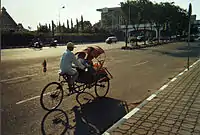
Bus
The main bus terminal is Terminal Purabaya (located in Bungurasih, Waru, Sidoarjo), the other major terminal is Osowilangon in Tambak.[151]
Public transport
There are various kinds of local transport, including taxi-cabs, Suroboyo Bus, shuttle bus service, city bus, Angguna, and Commuter rail. Go-Jek and Grab are also available.[152][153]
Suramadu Bridge
The Suramadu Bridge (derived from Surabaya-Madura) connects Surabaya and Madura Island over the Madura Strait. A 16 kilometres (9.9 mi) highway has been proposed to be built from the Suramadu Bridge to Madura International Seaport-City in Pernajuh village, Kocah district, Bangkalan, Madura at the cost of approximately Rp. 60 billion (US$7 billion). This container port was built to ease the burden on Surabaya's overloaded Tanjung Perak Port.[154]
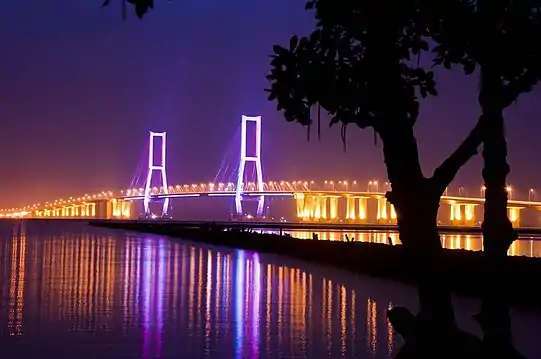
Education
Universities and post-secondary institutions
Surabaya has several major universities and institutions, including those with religious or technical specialties (sorted by importance):
- Airlangga University (UNAIR), a major public research university in Indonesia based in Surabaya and Banyuwangi.[155]
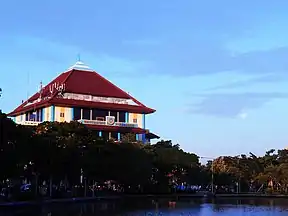
- Universitas 17 Agustus 1945 (Untag) Surabaya, one of the oldest private universities in Surabaya.
- Sepuluh Nopember Institute of Technology (ITS), a major public technological institute teaches robotics and mechanics, and is the center of Ship and Ocean Structure Design to support offshore exploration.[156]
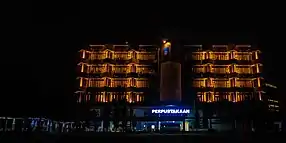
- State University of Surabaya (UNESA), a major university educating teachers; also with programs in Economics, Technology, and Law.[157]
- Universitas Kristen Petra, a major and oldest Christian private university in Indonesia, with programs in Economics, Technology, Designs, Technical, Literature and Education. Established in 1961, was the oldest major Christian university in Indonesia.[158]
- Electronic Engineering Polytechnic Institute of Surabaya (PENS-PPNS), a major technical public institution located in Surabaya.[159]
- Hang Tuah University, a university managed by Yayasan Nala, founded by Indonesian Navy.[160]
- Universitas Bhayangkara, a university affiliated with Indonesian Police Department of East Java.[161]
- Institut Sains Terapan dan Teknologi Surabaya, a private institute specializing in electronics, computer technologies, and communication and product design.[162]
- Universitas Pembangunan Nasional "Veteran" Jawa Timur, an Public institute in Surabaya.[163]
- Adhi Tama Institute of Technology Surabaya, an institute specializing in Technical Studies.[164]
- State Islamic University of Sunan Ampel (UINSA), a public university for Islamic studies.[165]
- University of Surabaya, a private university teaching Pharmacy and Psychology, established in 1968.[166]
- Wijaya Putra University a public University established in 1984.[167]
- Wijaya Kusuma University Surabaya, a university which is the oldest private faculty of medicine in eastern Indonesia. Established in 1981, The Faculty of Medicine was founded in 1986.[168]
- Widya Mandala Catholic University, a Catholic private university in Surabaya with facilities for Healthcare Studies at a newly opened third campus in the eastern part of the city. Widya Mandala Catholic University one of the Catholic oldest private universities in Surabaya which was established in 1960.[169]
- Widya Kartika Catholic University, a Catholic private university in Surabaya.[170]
- Pelita Harapan University, a private university in Indonesia founded in 1994.[171]
- Ciputra University, a private entrepreneurial-oriented university founded in 2006 by the Ciputra Group.[172]
- Narotama University (UNNAR), a private university in Surabaya.[173]
Primary and secondary schools
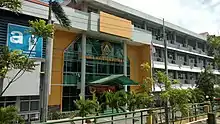
International schools include:
- Surabaya Intercultural School[174]
- Surabaya Japanese School (スラバヤ日本人学校)[175]
- Surabaya Taipei International School; 印尼泗水臺灣學校)[176]
- Surabaya European School[177]
- Merlion school[178]
Private schools include:
Cuisine
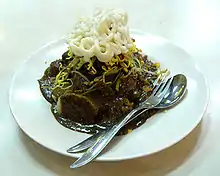
As a metropolitan city, all types of Indonesian cuisine and other international restaurants have a presence.[185] However, as the capital of East Java, cuisines from the rest of the province dominates the culinary culture of the city. East Javanese cuisines include a variety of processed fruits, crispy tempeh, Bakpao telo, Bakso Malang, Rawon, tahu campur lamongan, Cwie noodles, tahu takwa, tahu pong, getuk pisang, pecel madiun, wingko, tape, nasi krawu, otak-otak bandeng, bonggolan, shrimp crackers, shrimp paste or petis, Tempeh Chips, tahu tepo, Nasi lethok, sego tempong, salad soup, pecel rawon, Suwar-suwir, tape proll, gaplek, lodho, goat satay, and pecel tulungagung.[186]
Surabaya is famous for Rawon, Rujak cingur, Semanggi, Lontong Balap, clams satay, mussels, and rice cake.[187]
- Rujak cingur:[188] a marinated cow snout or lips and noses (cingur), served with boiled vegetables and shrimp crackers. It is then dressed in a sauce made of caramelised fermented shrimp paste (petis), peanuts, chili, and spices. It is usually served with lontong, a boiled rice cake. Rujak cingur is considered traditional food of Surabaya.
- Rawon: a dark beef soup, served with mung bean sprouts and the ubiquitous sambal. The dark (almost black) color comes from the kluwak (Pangium edule) nuts.[189]
- Lontong kupang: lontong with small cockles in petis sauce.[190]
- Semanggi: a salad made of boiled semanggi (M. crenata) leaves that grow in paddy fields. It is dressed in a spicy peanut sauce. It's usually eaten with rice crackers.[191]
Sports
Surabaya is a barometer and center of association football development in Indonesia. The city has many association football clubs and founded in Surabaya. The first club was founded by the youth of Hoogere Burger School (HBS) John Edgar with the Victoria club in 1895.[192][193] Others included Scoren Is Ons Doel (SIOD), Sparta, Rapiditas and Thot Heil Onzer Ribben (THOR). These are the pioneers of association football in Surabaya. The clubs then took management under Oost Java Voetbalbond (OJVB) in 1907. Two years later, the OJVB changed to Soerabajasche Voetbalbond (SVB). Starting in 1914, SVB was based on the Nederlandsch Indische Voetbalbond (NIVB), created by Dutch football federation (KNVB). The Surabaya Chinese and native people also founded their association football clubs by ethnicity. Oei Kwie Liem founded Hoa Soerabaja in 1914, while the Bumiputera through R Pamoedji and Paidjo founded the Soerabajasche Indonesische Voetbalbond (SIVB) on 18 June 1927 (now Persebaya), which three years later is a club who co-founded PSSI.[194][193]
In 1950, the working-class people and office men founded Soerabajasche Kantoor Voetbalbond (SKVB).[195][196] The association football sector in Indonesia and specifically Surabaya became more developed, and the football association of Indonesia founded a semi-professional competition in 1979, which was named the Main Football League (Galatama). A new team emerged from Surabaya, NIAC Partners and the Salim Group Association. Besides Galatama, PSSI also formed a women's soccer competition called the Women's Football League (Galanita). Surabaya also has a women's soccer team which was founded in 1977 and named Puteri Puspita. Clubs from Surabaya have also gained attention from the rest of the world. Persebaya has competed against European teams including Lokomotiv Moscow, Sturm Graz, Grasshoppers, Salzburg, Stade de Reims, Ajax Amsterdam, PSV Eindhoven, AC Milan, and lastly, Queens Park Rangers (QPR). Aside from European teams, there are several national teams outside the country competing against Persebaya, including Yugoslavia Olympics, Malaysia, Mozambique, Uruguay, Thailand, South Korea, and the Japanese national team.[196]
NIAC Mitra also competed against Arsenal and won the Aga Khan Gold Cup competition in 1979 in Bangladesh. The achievements of NIAC Mitra in the Galatama competition included champions three times in 1980–1982, 1982–1983, 1987–1988, and were runners-up in 1988–89. However, NIAC Partners officially dissolved and withdrew from the Galatama competition held by PSSI in 1990 because they considered the policies issued by PSSI irrelevant. After being disbanded, the demands of the Surabaya community to revive the NIAC Partners were channelled when the Jawa Pos party weighed in and changed the name of the NIAC Partner to the Surabaya Partner.[197] When the Union competition was merged with Galatama in 1994, the new Persebaya was able to win in 1997 and 2004. Persebaya was listed as the first team capable of winning the Indonesian League twice. Mitra Surabaya was only able to exist until the 1998–1999 season and it was re-established again in another city, Tenggarong and has not used the name of Surabaya again.[198]
Recently, only Persebaya has stable fans and achievements. Persebaya has won the Indonesian Premier Division three times–twice when the division was the first tier and once as the second tier. Fans refer to themselves as Bonek, an abbreviation for Bondo Nekat (which translates as "equipped by bravery"). The city is the home of CLS Knights Indonesia, a basketball club which participated in IBL (Indonesia basketball league) & Asean Basketball League.
Surabaya has a multi-purpose stadium, Gelora Bung Tomo Stadium. The stadium is used mostly for football matches. It is the new home stadium of Persebaya, replacing Gelora 10 November Stadium.[199] It was the venue of a match between Persebaya 1927 against then–English Premier League club Queens Park Rangers, held on 23 July 2012.
Another prevalent sport is badminton. There are numerous schools and clubs in the city that train students of various ages to reach the next level of the Badminton League.[200] Many children start out their career from Surabaya and have made it to the national and sometimes international level.
Media
.jpg.webp)
One of the largest circulating national newspaper in Indonesia, Jawa Pos, is headquartered in Surabaya; alongside its media conglomerate Jawa Pos Group. Major newspapers include Surabaya Pagi and Surya.
Surabaya is served by many radio and television networks. Radio networks affiliates include the public RRI Surabaya, Gen FM Surabaya and Prambors FM Surabaya; as well as local stations Suara Surabaya and Radio Istara. Local television stations include the public TVRI Jawa Timur, JTV (both are regional stations serving East Java, which are based in the city), SBO TV, Surabaya TV and Nahdlatul Ulama-affiliated TV9.
International relations
General Consulates
Consulates
|
|
Other diplomatics
- Taiwan (Taipei Economic and Trade Office in Surabaya)[227]
Twin towns (sister cities)
Surabaya is twinned with:[228]
 Kitakyushu, Japan (since 1992)
Kitakyushu, Japan (since 1992) Seattle, United States (since 1992)[229]
Seattle, United States (since 1992)[229]
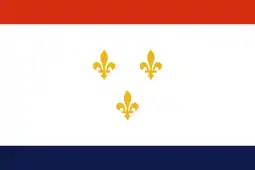 New Orleans, United States
New Orleans, United States Portland, United States
Portland, United States Johor Bahru, Malaysia
Johor Bahru, Malaysia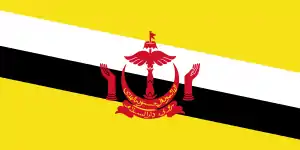 Kuala Belait, Brunei Darussalam
Kuala Belait, Brunei Darussalam The Hague, Netherlands
The Hague, Netherlands Busan, South Korea (since 1994)[230]
Busan, South Korea (since 1994)[230] İzmir, Turkey (since 1996)[231]
İzmir, Turkey (since 1996)[231] Varna, Bulgaria
Varna, Bulgaria Alexandria, Egypt
Alexandria, Egypt Kaoshiung, Taiwan
Kaoshiung, Taiwan Kōchi, Japan (since 1997)[232]
Kōchi, Japan (since 1997)[232] Monterrey, Mexico (since 2001)
Monterrey, Mexico (since 2001) Guangzhou, China (since 2005)[233]
Guangzhou, China (since 2005)[233] Xiamen, China (since 2008)[234]
Xiamen, China (since 2008)[234] Liverpool, United Kingdom (since 2017)[235]
Liverpool, United Kingdom (since 2017)[235]
Gallery
 Mosque in Surabaya
Mosque in Surabaya Handelstraat (Red Bridge) 1930s
Handelstraat (Red Bridge) 1930s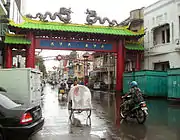 Kya-Kya or Kembang Jepun, the city's Chinatown
Kya-Kya or Kembang Jepun, the city's Chinatown
References
Citations
- Munoz, Paul Michel (2006). Early Kingdoms of the Indonesian Archipelago and the Malay Peninsula. Continental Sales, Incorporated. p. 246. ISBN 9789814155670.
- "Pasar Keputran Utara | Pasar Surya".
- Perkembangan Kota Dan Arsitektur Kolonial Belanda Di Surabaya, 1870–1940. Diterbitkan atas kerjasama Lembaga Penelitian dan Pengabdian kepada Masyarakat, Universitas Kristen PETRA Surabaya dan Penerbit ANDI Yogyakarta. 1 January 1996. ISBN 9789795333739 – via Google Books.
- "Indonesia: Java (Regencies, Cities and Districts) – Population Statistics, Charts and Map".
- "Demographia World Urban Areas, 16th Annual Edition" (PDF). February 2020. Retrieved 24 June 2020.
- "PU-net". perkotaan.bpiw.pu.go.id.
- Statistics Indonesia. "Surabaya Municipality in Figures 2017". surabayakota.bps.go.id. Archived from the original on 1 April 2019. Retrieved 1 April 2019.
- "BPS Provinsi Jawa Timur". jatim.bps.go.id.
- "Indeks Pembangunan Manusia | Kota Surabaya". ipm.bps.go.id. Archived from the original on 1 April 2019. Retrieved 1 April 2019.
- "26. Z. Irian Jaya". bappenas.go.id (Word DOC) (in Indonesian).
- Geografi. Grasindo. p. 114. ISBN 978-979-759-619-4.
- Dick, Howard W. (2003). Surabaya, City of Work: A Socioeconomic History, 1900–2000. Research in international studies: Southeast Asia series. 106. Singapore University Press. ISBN 978-9971-69-264-3.
- Pigeaud 1976, p. 16.
- Ricklefs 2008, p. 39.
- Pigeaud 1976, p. 28.
- Akhmad Saiful Ali 1994, p. 32.
- "Surabaya Siap Jadi Penghubung Perdagangan Indonesia Timur". Republika Online (in Indonesian). 17 November 2017. Retrieved 6 March 2019.
- "Welcome to Surabaya City, East Java". Surabaya Tourism, EastJava.com. Retrieved 17 November 2014.
- Hananto, Akhyari. "Asal Nama "Surabaya", Ternyata bukan Hiu dan Buaya". Good News From Indonesia (in Indonesian). Retrieved 3 January 2019.
- Irwan Rouf & Shenia Ananda (1 January 2013). Rangkuman 100 Cerita Rakyat Indonesia dari Sabang sampai Merauke: Asal Usul Nama Kota Surabaya (in Indonesian). MediaKita. p. 60. ISBN 9786029003826. Retrieved 17 November 2014.
- Graf, Arndt; Chua, Beng Huat (2008). Port Cities in Asia and Europe. Routledge. ISBN 978-1-135-78478-2.
- "Patung Suro dan Boyo di Surabaya | Jalan Jalan Yuk!". www.jalanjalanyuk.com. Retrieved 5 January 2019.
- Suaramuslim.net (1 June 2018). "Soerabaia Tempo Doeloe "Lambang Kota Surabaya"". Suara Muslim (in Indonesian). Retrieved 3 January 2019.
- F. Hirth and W.W. Rockhill, Chau Ju-kua, St Petersburg, 1911
- duniakeris (19 January 2018). "Bagaimana Bika Ujung Galuh Bukan Surabaya Kini". DUNIA KERIS-US. Retrieved 5 January 2019.
- Ma Huan Ying-yai Sheng-lan, The Overall Survey of Ocean Shore, translated by J.V.G. Mills, p. 90, 1970, Hakklut Society, reprint by White Lotus, 1997. ISBN 974-8496-78-3.
- Ma Huan; JVG Mills (1970). "Ying-yai Sheng-lan, The Overall Survey of the Ocean's Shores" (PDF). Washington.edu. pp. 86–97 (Country of Chao–Wa).
- ID, Pecinta Ulama. "Sejarah Singkat Masjid Agung Sunan Ampel (MASA) Surabaya". Pecinta Ulama. Retrieved 3 January 2019.
- Ricklefs 2008, p. 43.
- Akhmad Saiful Ali 1994, p. 31.
- Drakeley S. The History of Indonesia. Greenwood, 2005. ISBN 9780313331145
- Margana, Sri (2007). Java's last frontier : the struggle for hegemony of Blambangan, c. 1763–1813. Leiden: TANAP. pp. 210–236. Retrieved 17 February 2016.
- Salmon, Claudine (1997). "La communauté chinoise de Surabaya. Essai d'histoire, des origines à la crise de 1930". Archipel. 53: 121–206. doi:10.3406/arch.1997.3396.
- Peter James Rimmer; Howard W. Dick (2009). The City in Southeast Asia: Patterns, Processes and Policy. NUS Press. p. 32. ISBN 978-9971-69-426-5.
- Achdian, Andi. "Sebelum PKI Berdiri: Lingkaran Kaum Sosialis di Surabaya". tirto.id (in Indonesian). Retrieved 5 January 2019.
- "Japanese hand over power in Surabaya and Yogyakarta". End of Empire-US. 2 October 2015. Retrieved 4 March 2019.
- "Indonesian Memorial Day". IndonesianPod101. Retrieved 4 March 2019.
- "[Hari Pahlawan] Battle of Surabaya, the Story behind Indonesia's Heroes Day". Global Indonesian Voices – GIV-US. 9 November 2014. Retrieved 4 March 2019.
- "Surabaya, a miniature of Singapore". 5 September 2011.
- "Khofifah Benarkan Kasus Positif COVID-19 Pertama di Jatim". Suara Surabaya (in Indonesian). Archived from the original on 17 April 2020. Retrieved 17 April 2020.
- "World Weather Information Service – Surabaya". World Meteorological Organization. Retrieved 11 December 2017.
- "Surabaya climate: Average Temperature, weather by month, Surabaya weather averages – Climate-Data.org". en.climate-data.org. Retrieved 6 November 2018.
- "INDONESIA – SURABAJA". www.globalbioclimatics.org. Retrieved 14 December 2018.
- "INDONESIA – SURABAJA (google web cache)". webcache.googleusercontent.com. Retrieved 14 December 2018.
- "Total Hours of Sunshine – Surabaya – Climate Robot Indonesia". www.weatheronline.co.uk. Retrieved 15 April 2020.
- "Surabaya weather in 2015 – Indonesia climate – Climatevo.com". 11 August 2015. Archived from the original on 11 August 2015. Retrieved 27 January 2019.
- "Surabaya, Indonesia – Monthly weather forecast and Climate data". Weather Atlas. Retrieved 24 January 2019.
- Times, I. D. N.; Bastam, Rudy. "Surabaya Jadi Nominasi Kota Terbersih ASEAN, Ini Strategi Risma". IDN Times (in Indonesian). Retrieved 4 March 2019.
- Finansialku (11 March 2018). "27 Taman di Surabaya yang Sangat Cantik dan Cocok Untuk Foto Instagram". Finansialku Perencana Keuangan Independen (in Indonesian). Retrieved 4 March 2019.
- "Taman Jayengrono, the Oldest Park Full of Struggle in Surabaya – HERSYA FRONT ONE INN SURABAYA". hersyafrontoneinnsurabaya.com (in Indonesian). Retrieved 4 March 2019.
- "Surabaya's Bungkul Park Nabs 2013 Asian Townscape Award". Tempo. 28 November 2013. Retrieved 4 March 2019.
- Syahroni, Muhammad. "Dampak Pandemi di Kota Surabaya Dalam Dunia Pendidikan". Infokuota.com (in Indonesian). Retrieved 10 January 2020.
- Tajuddin, Muhammad. "Surabaya Menjadi Kota Favorit Para Pekerja". Apamasalahmu.com (in Indonesian). Retrieved 7 January 2020.
- Rahman, Farid. "Malaysia Berguru ke Pemkot Surabaya Soal Pengelolaan Lingkungan". Ngopibareng.id (in Indonesian). Retrieved 4 March 2019.
- antaranews.com (12 December 2018). "Petaling Jaya Malaysia adopsi pengelolaan lingkungan Surabaya". Antara News. Retrieved 4 March 2019.
- Surabaya, Kukuh S. Wibowo (19 July 2016). "Surabaya Raih Tujuh Adipura Berturut-turut". Tempo (in Indonesian). Retrieved 4 March 2019.
- Khoiri, Ahmad Masaul. "Menhut Siti: Bandung dan Surabaya Jadi Kota dengan Kualitas Udara Terbaik". detiknews (in Indonesian). Retrieved 4 March 2019.
- "Tri Rismaharini". World Bank Live. 25 September 2014. Retrieved 4 March 2019.
- "Surabaya Raih Penghargaan Lee Kuan Yew. Risma Akan Tampil di Dua Forum | Surabaya Bisnis.com". Bisnis.com (in Indonesian). Retrieved 4 March 2019.
- "2018 Special Mention: Surabaya". www.leekuanyewworldcityprize.com.sg. Retrieved 3 January 2019.
- Puruhito, Qowiy. "Pemukiman Kumuh di Surabaya, Siapa yang Salah?". Good News From Indonesia (in Indonesian). Retrieved 4 March 2019.
- "Kawasan Kumuh di Surabaya Capai 150 Hektar". rri.co.id (in Indonesian). Retrieved 4 March 2019.
- Republika (24 August 2017). "Rusunawa Disiapkan untuk Warga di Daerah Kumuh Surabaya". www.republika.co.id.
- BPS Provinsi Jawa Timur. "Jumlah Anggota Dewan Perwakilan Rakyat Daerah Menurut Kabupaten/Kota dan Jenis Kelamin di Provinsi Jawa Timur, 2015". jatim.bps.go.id (in Indonesian). Retrieved 6 March 2019.
- "Command Center 112 Untuk Warga Kota Surabaya". polrestabessurabaya.com (in Indonesian). Retrieved 6 March 2019.
- JawaPos.com (17 July 2017). "Kisah-Kisah di Balik Beroperasinya Command Center (CC) 112 Surabaya". www.jawapos.com (in Indonesian). Retrieved 6 March 2019.
- "Rahasia Tri Rismaharini Bangun Surabaya Juara Kota Cerdas". Kompas. Retrieved 11 January 2019.
- "Sabet Juara Kota Cerdas, Ini Penghargaan yang Pernah Diterima Surabaya". Kompas. Retrieved 11 January 2019.
- "Surabaya City Regulation No. 5 2006" (PDF). Archived from the original (PDF) on 28 September 2007.
- Biro Pusat Statistik, Jakarta, 2011.
- Dick, Howard W. (2003). Surabaya, City of Work: A Socioeconomic History, 1900–2000. Singapore University Press. ISBN 9789971692643.
- "Page:The New International Encyclopædia 1st ed. v. 18.djvu/816 – Wikisource, the free online library". en.wikisource.org. Retrieved 24 December 2018.
- Ingleson, John (2014). Workers, Unions and Politics: Indonesia in the 1920s and 1930s. BRILL. p. 12. ISBN 9789004264762.
- "Surabaya Population Data (Urban Area)". worldpopulationreview.com. Retrieved 24 December 2018.
- "Gatra.Com". Gatra.Com. 25 August 2015. Retrieved 4 March 2013.
- Statistics Indonesia, BPS (25 December 2017). "Statistik Komuter Gerbangkertosusila Hasil Survei Komuter Gerbangkertosusila 2017". bps.go.id. Archived from the original on 6 January 2019.
- "Migration to Surabaya City: 1996". www.kicc.jp. Retrieved 4 March 2019.
- "Surabaya Old City – The Swanky City". Indohoy. Retrieved 4 March 2019.
- "Demografi Surabaya". Surabaya.go.id (in Indonesian). Pemerintah Kota Surabaya. Retrieved 13 January 2020.
- Indonesia, PT Rima News. "Surabaya, Kota Multi-etnis Cermin Indonesia | Rimanews.com". Rimanews.com (in Indonesian). Retrieved 5 January 2019.
- Karina, Ernia (9 January 2015). "Cuma Arek-Arek Suroboyo yang Mengalami Gejolak Perjuangan Hidup Seperti Ini!". Hipwee (in Indonesian). Retrieved 5 January 2019.
- Budi, Arifina. "Ini Keunikan yang Hanya Dimiliki Masyarakat Jawa Timur". Good News From Indonesia (in Indonesian). Retrieved 5 January 2019.
- Rachman, Rio F. (26 May 2016). "Sirikit Syah: Boso Suroboyoan Simbol Terus Terang – SUROBOYO.id". Berita Surabaya-US. Retrieved 5 January 2019.
- "Surabaya Municipality in Figures 2017". Statistics Indonesia (in Indonesian). Retrieved 23 August 2019.
- Jakarta, Indoindians (23 January 2019). "Indian Association of Surabaya (IAS)". Indoindians-US. Retrieved 27 January 2019.
- "The Jewish Community of Indonesia". Beit Hatfutsot-US. Retrieved 27 January 2019.
- "Napak Tilas Bimas Islam Ke Masjid-masjid Bersejarah di Surabaya – Website Bimas Islam (Direktorat Jenderal Bimbingan Masyarakat Islam Kementerian Agama)". bimasislam.kemenag.go.id. Retrieved 27 January 2019.
- Online, N. U. "Sejarah dan Gerakan Berdirinya NU". NU Online-us. Retrieved 5 January 2019.
- "Masjid Al Akbar Surabaya". Pusaka Jawatimuran-US. 2 October 2016. Retrieved 5 January 2019.
- "Komite Perekat Persaudaraan Maluku di Surabaya Gelar Perayaan Natal 2017". Kabar Emansipasi News (in Indonesian). 16 January 2018. Retrieved 6 March 2019.
- "Ketika Orang Batak di Jatim Kukuhkan Pengurus Pesaudaraan Rantau". kumparan (in Indonesian). Retrieved 6 March 2019.
- Firman, Tony. "Dakwah Kristen Jawa ala Coenrad Laurens Coolen". tirto.id (in Indonesian). Retrieved 6 March 2019.
- "Arsitektur Kastil ala Gereja Kepanjen – actasurya.com" (in Indonesian). Retrieved 6 March 2019.
- "Yayasan Orthodox Center Surabaya". orthodox.or.id (in Indonesian). 18 April 2010. Archived from the original on 18 April 2010. Retrieved 23 August 2019.
- "Kerajaan Janggala, Bandar Perdagangan Terbesar Kedua di Nusantara". kumparan (in Indonesian). Retrieved 27 January 2019.
- "Jagat Karana Adalah Tempat Ibadah Umat Hindu Di Kota Surabaya". www.eastjava.com. Retrieved 5 January 2019.
- Lestari, Sri (2 June 2018). "Mengenal komunitas Yahudi di Indonesia" (in Indonesian). Retrieved 6 March 2019.
- "Indonesia's last synagogue, an intended heritage site, destroyed". www.timesofisrael.com.
- "The Jewish Community of Indonesia". The Museum of the Jewish People at Beit Hatfutsot.
- Champagne, Jessica; Aziz, Teuku Cut Mahmud (2003). "The Jews of Surabaya". Latitudes Magazine.
- "Celetuk Dagelan Ludruk". Historia – Obrolan Perempuan Urban (in Indonesian). Retrieved 5 January 2019.
- "Melestarikan Tari Remo, Menjaga Identitas Bangsa". VOA Indonesia (in Indonesian). Retrieved 5 January 2019.
- "Cak dan Ning Sapaan Akrab Arek Suroboyo". Pusaka Jawatimuran (in Indonesian). 15 October 2016. Retrieved 4 March 2019.
- "Sejarah – Cak Durasim" (in Indonesian). Retrieved 5 January 2019.
- Suara Surabaya, (E100). "Surabaya Cross Culture 2018 Akan Pamerkan Lintas Budaya dari 10 Negara". suarasurabaya.net (in Indonesian). Retrieved 5 January 2019.
- "Surabaya History Facts and Timeline: Surabaya, East Java, Indonesia". www.world-guides.com. Retrieved 27 January 2019.
- Zanden, Jan Luiten van; Marks, Daan (2 May 2013). An Economic History of Indonesia: 1800–2010. Routledge. ISBN 978-1-136-45460-8.
- surabaya.go.id. "Sosial Ekonomi". www.surabaya.go.id (in Indonesian). Retrieved 5 January 2019.
- Primadhyta, Safyra. "Teror Bom, BI Pastikan Surabaya Jadi Pusat Ekonomi Syariah". ekonomi. Retrieved 5 January 2019.
- Indonesia, Rima News. "Surabaya Pusat Ekonomi Syariah di Indonesia". Rimanews.com (in Indonesian). Retrieved 5 January 2019.
- Ramadhan, Bagus. "Surabaya, Kota Ujung Tombak Poros Maritim Indonesia". Good News From Indonesia (in Indonesian). Retrieved 5 January 2019.
- "Daftar Perusahaan di Surabaya, Profil Perusahaan di Surabaya". www.daftarperusahaan.com. Retrieved 5 January 2019.
- "Perusahaan dan Startup Asal Surabaya". Qerja-US. 27 September 2018. Retrieved 5 January 2019.
- "Tunjungan Street, The Witness of Moments – Surabaya". www.indonesia-tourism.com. Retrieved 6 March 2019.
- "Tunjungan City | PressReader.com". www.pressreader.com. Retrieved 5 January 2019.
- suarasurabaya.net. "Masa Depan Jalan Tunjungan Surabaya". suarasurabaya.net (in Indonesian). Retrieved 5 January 2019.
- "Citraland Pusat Bisnis Baru di Surabaya Barat – beritajatim.com". beritajatim.com. Retrieved 5 January 2019.
- Media, Kompas Cyber (12 December 2016). "Masa Depan Surabaya Ada di Daerah Barat". KOMPAS.com (in Indonesian). Retrieved 5 January 2019.
- "Luar Biasa, Luas Seluruh Mal di Surabaya Tembus 96,7 Hektar". Kompas. Retrieved 9 May 2018.
- "BG Junction :: About". www.bgjunction.com. Retrieved 22 June 2020.
- W, Haryo JK, Aristian. "Grand City Mall & Convex – Surabaya". www.grandcitysurabaya.com. Retrieved 22 June 2020.
- "Sutos | Townsquare HEEEL". Retrieved 22 June 2020.
- "World Trade Center Surabaya". WTC Surabaya. Retrieved 20 June 2020.
- "WTC EMALL – The Biggest Gadget Mall – World Trade Center Surabaya". wtcemall.com. Retrieved 20 June 2020.
- Ting, Kennie (19 September 2012). "The Colonial City, or Old Town West – Surabaya". Dream of a City. Retrieved 5 January 2019.
- Alda, Michelle. "Mengenal Bangunan Kolonial Belanda Surabaya Karya Estourgie". detiknews (in Indonesian). Retrieved 4 March 2019.
- Monda (21 February 2016). "Keunikan Kota Tua Surabaya". Berbagi Kisahku-US. Retrieved 6 March 2019.
- Times, I. D. N.; Sofi, Habibah. "10 Bangunan Tua Ini Bukti Surabaya Punya Warisan Sejarah yang Epik". IDN Times (in Indonesian). Retrieved 6 March 2019.
- Suhendra. "Parade Gedung Pencakar Langit". tirto.id (in Indonesian). Retrieved 5 January 2019.
- "Cheng Hoo Mosque Surabaya". www.eastjava.com. Retrieved 4 March 2019.
- "Masjid Al-Akbar". Humas Jakarta Islamic Centre and 27th ISLAND (in Indonesian). DuniaMasjid.com. Archived from the original on 1 January 2013. Retrieved 6 January 2013.
- Baihaqi, Amir. "Menengok Gereja Kepanjen yang Tertua di Surabaya". detiknews (in Indonesian). Retrieved 4 March 2019.
- "The Heroes Monument : It had built for the agenda of giving high respect to all warriors that had killed during big encounter to fight against ally army being hitchhiked by NICA". www.eastjava.com. Retrieved 4 March 2019.
- "Melihat Jejak Nahdlatul Ulama di Museum NU Surabaya – HERSYA FRONT ONE INN SURABAYA". hersyafrontoneinnsurabaya.com (in Indonesian). Retrieved 4 March 2019.
- "Gedung De Javasche Bank Surabaya". Dolan Dolen (in Indonesian). 26 August 2017. Retrieved 4 March 2019.
- "House of Sampoerna". houseofsampoerna.museum.
- "Welcome to Submarine Monument Surabaya, Indonesia : A real Russian submarine in the Indonesia's Navy Armada".
- "Kenjeran Beach : Kenjeran Beach are more sport activities, such as; Tennis, Horseracing, Motorbike, Race, Swimming, Fishing, Playground, and places of worship". www.eastjava.com. Retrieved 4 March 2019.
- "Pasar Bong – Surabaya". wikimapia.org.
- Harsaputra, Indra (19 September 2009). "The Jakarta Post". Former Chinese cemetery serves as bustling market. Retrieved 17 February 2016.
- "RUMAH ABU HAN – DOCUMENTARY FILM". Vimeo.
- Azali, Kathleen (2012). "Rumah Abu Han, a historic ancestral house in Surabaya" (PDF). The Newsletter (International Institute for Asian Studies). 59 (Spring). Retrieved 17 February 2016.
- Fitrianto, Heri Agung (7 July 2013). "Kompasiana". Jejak Sang Kapiten Di Rumah Abu Keluarga Han. Retrieved 17 February 2016.
- "Ampel Mosque, Ampel Tomb, Arab Market : Surabaya Pilgrimage Spot | GETAWAY TOURS : Indonesia Tour Operator, Reliable and Trustworthy for your Java & Indonesia Trip-US". Retrieved 4 March 2019.
- admin; Groen, Marco de (2 May 2014). "Bungkul City Park, Surabaya". The Daily Roar-US. Retrieved 4 March 2019.
- Mediatama, Grahanusa (30 September 2016). "Cerita satu dasawarsa Intiland melawan krisis". kontan.co.id (in Indonesian). Retrieved 4 March 2019.
- "https://surabaya.liputan6.com/read/4119240/4-potret-museum-pendidikan-belajar-sejarah-sambil-berwisata-di-surabaya". Retrieved 7 March 2020. External link in
|title=(help) - The Submarine Monument. "Welcome to Submarine Monument Surabaya, Indonesia : A real Russian submarine in the Indonesia's Navy Armada". eastjava.com.
- "Monkasel (Submarine Monument)". tripadvisor.com.
- "Hari Ini, Jalan Tol Jakarta-Surabaya Akhirnya Tersambung". KOMPAS (in Indonesian). 20 December 2018. Retrieved 6 March 2019.
- Andy Kristono (20 June 2012). "Rute Bus Kota di Surabaya | Surabaya Bus". Surabaya Rek!-US. Retrieved 5 January 2019.
- Media, Kompas Cyber (9 February 2009). "Kereta Komuter Dalam Kota Beroperasi di Surabaya". KOMPAS.com (in Indonesian). Retrieved 5 January 2019.
- "Bus Suroboyo: Membayar tiket transportasi memakai sampah plastik". BBC News Indonesia. 27 September 2018. Retrieved 5 January 2019.
- "Surabaya's hotel business boom "likely to continue"". The Jakarta Post. Archived from the original on 30 May 2013. Retrieved 4 March 2013.
- "History of Airlangga University". www.unair.ac.id. Retrieved 2 February 2019.
- "About ITS". Institut Teknologi Sepuluh Nopember. Retrieved 2 February 2019.
- "Selayang Pandang tentang UNESA". www.unesa.ac.id (in Indonesian). Retrieved 2 February 2019.
- "About Christian Petra University". www.petra.ac.id. Retrieved 2 February 2019.
- "About PENS Surabaya". Politeknik Elektronika Negeri Surabaya.
- "About Hang Tuah University". hangtuah.ac.id. Retrieved 2 February 2019.
- "About Bhayangkara University". Universitas Bhayangkara Surabaya.
- "Sekolah Tinggi Teknik Surabaya". www.stts.edu. Retrieved 2 February 2019.
- "Sejarah – UPN "Veteran" Jawa Timur" (in Indonesian). Retrieved 2 February 2019.
- "Profil ITATS". ITATS Institut Teknologi Adhi Tama Surabaya-US. Retrieved 2 February 2019.
- "UIN Sunan Ampel Surabaya | Building Character Qualities: For the Smart, Pious, Honorable Nation". www.uinsby.ac.id. Retrieved 2 February 2019.
- Surabaya, Management Information System-Universitas. "Tentang Ubaya". Universitas Surabaya (Ubaya). Retrieved 2 February 2019.
- "Sejarah Singkat UWP". uwp.ac.id. Retrieved 2 February 2019.
- "Tentang UWKS". Universitas Wijaya Kusuma Surabaya (in Indonesian).
- "Sekilas | UKWMS" (in Indonesian). Retrieved 2 February 2019.
- "Widya Kartika " Sejarah". widyakartika.ac.id. Retrieved 2 February 2019.
- "Universitas Pelita Harapan". surabaya.uph.edu. Retrieved 2 February 2019.
- "Tentang Universitas Ciputra". Creating World Class Entrepreneur-US. Retrieved 2 February 2019.
- "Tentang dan Sejarah Universitas Narotama | Universitas Narotama". narotama.ac.id. Retrieved 2 February 2019.
- "About Us". Surabaya Intercultural School-US. Retrieved 2 February 2019.
- "About Us". www.surabayajapaneseschool.com. Retrieved 2 February 2019.
- "Overseas Taiwan Schools – an Introduction". Ministry of Education Republic of China (Taiwan). 21 July 2016. Retrieved 23 August 2019.
- "British Schools Surabaya – History: Surabaya European School-US". Retrieved 2 February 2019.
- "Merlion School Surabaya |". Retrieved 20 January 2021.
- "Petra Christian School Board". pppkpetra.or.id. Retrieved 2 February 2019.
- "SMA Katolik St. Louis 1 (Sinlui) | St Louis 1 | 66th-US". Retrieved 2 February 2019.
- "SMAK St. Agnes". www.smak-stagnes-sby.sch.id. Retrieved 2 February 2019.
- "Profile Sekolah : SMP Katolik Angelus Custos (Sekolah Katolik Surabaya, Jawa Timur, Indonesia) :: AC :: Official Website". www.angeluscustos1.net. Retrieved 2 February 2019.
- "Sekolah Kristen Gloria". www.gloriaschool.org. Retrieved 2 February 2019.
- "School Profiles". www.iphschools.sch.id. Retrieved 2 February 2019.
- Putri, Edira. "The 10 Best Restaurants in Surabaya". Culture Trip. Retrieved 5 January 2019.
- "Tasty Indonesian Food – Surabaya Culinary Trip". Tasty Indonesian Food-US. Retrieved 5 January 2019.
- "5 Lip-Smacking Local Foods You Must Try in Surabaya". Trip101. 7 March 2016. Retrieved 5 January 2019.
- Tania, Vania (2008). Djakabaia: Djalan-djalan dan Makan-makan. Gramedia Pustaka Utama. ISBN 978-979-223923-2.
- "Indonesian Cuisine: Rawon". Surabaya Travel Guide-US. 29 October 2015. Retrieved 5 January 2019.
- Kaya, Indonesia. "Lontong Kupang, Lontong dengan Siraman Kerang Kecil Khas Surabaya – Situs Budaya Indonesia". IndonesiaKaya (in Indonesian). Retrieved 5 January 2019.
- www.alinea.id. "Mencicipi Semanggi, makanan tradisional khas Surabaya". alinea.id (in Indonesian). Retrieved 5 January 2019.
- Arifin, As'ad Syamsul (10 January 2012). "PERKEMBANGAN KLUB SEPAK BOLA SURABAYA 1900–1942". SKRIPSI Jurusan Sejarah – Fakultas Ilmu Sosial UM (in Indonesian). 0.
- Chusnuddin, Ahmad Arif (2 August 2016). "Kota Sepak Bola Itu Bernama Surabaya". Fandom Indonesia (in Indonesian). Retrieved 5 January 2019.
- Aji, Rojil Nugroho Bayu (2010). Tionghoa Surabaya dalam sepak bola, 1915–1942 (in Indonesian). Ombak. ISBN 9786028335294.
- Jemmy Husny Mubarak, 120210369 (2007). PERKEMBANGAN SIVB MENUJU KLUB PERSEBAYA TAHUN 1927–1978 (skripsi thesis) (in Indonesian). UNIVERSITAS AIRLANGGA.CS1 maint: numeric names: authors list (link)
- "Surabaya dan Sepakbolanya". Historia – Obrolan Perempuan Urban. Retrieved 5 January 2019.
- Saksono, Devana Bramantya; Santoso, Edy Budi (1 June 2015). "Niac Mitra Surabaya: Potret Pasang Surut Kesebelasan Sepak Bola Tahun 1979–1990". Verleden.
- Teguh, Irfan. "NIAC Mitra, Klub Surabaya Penakluk Arsenal". tirto.id (in Indonesian). Retrieved 5 January 2019.
- Siberkom, Agranet Multicitra (6 August 2010). "Gelora Bung Tomo Diresmikan, Lalu Lintas Macet". us.surabaya.detik.com (in Indonesian). Archived from the original on 22 August 2010. Retrieved 23 August 2019.
- "Geliat klub bulu tangkis di Nusantara (1)". beritagar.id (in Indonesian). Retrieved 6 March 2019.
- Australia, Department of Foreign Affairs (23 February 2019). "Australian Consulate-General in Surabaya". surabaya.consulate.gov.au-AU. Retrieved 23 February 2019.
- "Consulate-General of the People's Republic of China in Surabaya". surabaya.china-consulate.org. Retrieved 23 February 2019.
- "Daftar Perwakilan Negara Asing". surabaya.go.id (in Indonesian). Pemerintah Kota Surabaya. Retrieved 14 January 2020.
- "Mengenai kami : Konsulat Jenderal Jepang di Surabaya". www.surabaya.id.emb-japan.go.jp (in Indonesian). Retrieved 23 February 2019.
- "総領事館について : 在スラバヤ日本国総領事館". www.surabaya.id.emb-japan.go.jp (in Japanese). Retrieved 23 February 2019.
- "U.S. Consulate General Surabaya". U.S. Embassy & Consulates in Indonesia-US. Retrieved 23 February 2019.
- Bundesministerium für Europa, Integration und Äußeres. "About Us – Honorary Consulates in Surabaya". www.bmeia.gv.at. Retrieved 24 February 2019.
- "Contact details of the Honorary Consul of the Republic of Belarus in Surabaya (consular district – East Java)". indonesia.mfa.gov.by. Retrieved 23 February 2019.
- Jajeli, Rois. "Republik Belarus Buka Kantor Konsul Kehormatan di Surabaya". detiknews.
- Kingdom of Belgium (5 December 2014). "Belgian Honorary Consulates". Belgium in Indonesia. Retrieved 23 February 2019.
- Indonesia, Denmark in. "Surabaya, Østjava, Consulate". Denmark in Indonesia. Retrieved 23 February 2019.
- Timor-Leste Embassies and Consulates. "Honorary Consulate – Surabaya". timor-leste.gov.tl. Retrieved 24 February 2019.
- "Jaringan kerjasama Perancis di Indonesia". Ambassade de France en Indonésie, à Timor-Est et auprès de l’ASEAN (in Indonesian). Retrieved 23 February 2019.
- Indonesia, Harper's BAZAAR (11 July 2017). "Konsul Kehormatan Prancis Hadir di Surabaya". Harper's Bazaar Indonesia (in Indonesian). Retrieved 23 February 2019.
- "Diplomáciai kapcsolatok szintje". jakarta.mfa.gov.hu. Retrieved 23 February 2019.
- "Konsulat Jenderal India". IndonesiaYP (in Indonesian). Retrieved 23 February 2019.
- Mongolian Consulate. "Consulate of Mongolia in Surabaya". mongolianconsulate.org.
- Zaken, Ministerie van Buitenlandse (1 November 2012). "Konsulat Kerajaan Belanda di Surabaya – Indonesia – belandadananda.nl". www.belandadananda.nl (in Indonesian). Retrieved 23 February 2019.
- "Selandia Baru Buka Konsul Kehormatan di Surabaya". Jawa Pos Online (in Indonesian). Retrieved 23 February 2019.
- JAKARTA, Migracja WPHI. "Konsulat Kehormatan Republik Polandia di Bandung, Medan, Surabaya, Denpasar, dan Dili". Indonezja | Portal Promocji Eksportu (in Indonesian). Retrieved 23 February 2019.
- "Pertemuan dengan Konsul Kehormatan di Surabaya". dzakarta.msz.gov.pl. Retrieved 23 February 2019.
- Eidgenössisches Departement für auswärtige Angelegenheiten. "Consulate of Switzerland in Surabaya". www.eda.admin.ch. Retrieved 23 February 2019.
- "Sri Lanka Honorary Consulate in Surabaya". -US. Retrieved 23 February 2019.
- "Konsulat Jenderal Swedia". IndonesiaYP (in Indonesian). Retrieved 23 February 2019.
- "H.E. Mr. Songphol Sukchan, Ambassador of Thailand to Indonesia attended the dinner with Consul Generals and Honorary Consuls of foreign countries and Indonesian businessmen in Surabaya". สถานเอกอัครราชทูต ณ กรุงจาการ์ตา-US. 11 February 2019. Retrieved 23 February 2019.
- "British Ambassador opens new Visa Application Centre in Surabaya". GOV.UK-GB. Retrieved 23 February 2019.
- "首頁 – Taipei Economic and Trade Office in Surabaya 駐印尼泗水辦事處". www.roc-taiwan.org. Retrieved 24 February 2019.
- "Kegiatan Kerjasama Kota Surabaya Dengan Mitra Di Luar Negeri" [Cooperation Activities of Surabaya with Partners Overseas] (PDF). Surabaya City Government. Archived from the original (PDF) on 16 December 2013. Retrieved 15 February 2015.
- "Interactive City Directory: Surabaya, Indonesia". Sister Cities International. Archived from the original on 16 February 2015. Retrieved 15 February 2015.
- "List of Sister Cities". english.busan.go.kr. Busan Metropolitan City. Retrieved 18 February 2020.
- A.Ş, ÜNİBEL. "İzmir Büyükşehir Belediyesi". İzmir Büyükşehir Belediyesi. Retrieved 18 January 2019.
- "International Exchange". The International Council of Local Authorities for International Relations (CLAIR), Singapore. Retrieved 15 February 2015.
- "Sister Cities of Guangzhou". Guangzhou Foreign Affairs Office. Archived from the original on 4 March 2016. Retrieved 15 February 2015.
- 厦门市外事办-友城一览-厦门市20个国际友好城市名录 (in Chinese). Foreign Affairs Office, Xiamen People's Government. 18 August 2015. Retrieved 21 June 2019.
- "Vice Mayor of Liverpool Gary Miller visits Surabaya". GOV.UK. Retrieved 7 September 2018.
Bibliography
- Adi, Dhahana (2014). Surabaya Punya Cerita: Vol. 1, Volume 1 (in Indonesian). Yogyakarta: Indie Book Corner. ISBN 9786023090242.
- Airlangga University, Department of History (2013). Mengeja keseharian: Sejarah kehidupan masyarakat kota Surabaya (in Indonesian). Surabaya: Departemen Ilmu Sejarah UNAIR. ISBN 9789791854115.
- Akhmad Saiful Ali (1994). Ekspansi Mataram terhadap Surabaya Abad ke-17 (Thesis) (in Indonesian). Surabaya: Islamic Institute of Sunan Ampel.
- Basundoro, Purnawan (2013). Merebut Ruang Kota: Aksi Rakyat Miskin Kota Surabaya 1900-1960an (in Indonesian). South Tangerang: CV Marjin Kiri. ISBN 9789791260220.
- Dick, Howard W. (2002). Surabaya, City of Work: A Socioeconomic History, 1900–2000. Athens, Ohio: Ohio University Press. ISBN 978-0-89680-221-6.
- Ingleson, John (2014). Workers, Unions and Politics: Indonesia in the 1920s and 1930s. Boston: Brill Publishers. p. 12. ISBN 9789004264762. ISSN 2213-0527.
- Munoz, Paul Michel (2006). Early Kingdoms of the Indonesian Archipelago and the Malay Peninsula. Continental Sales, Incorporated. p. 246. ISBN 978-98-141-5567-0.
- Nasution (2006). Ekonomi Surabaya pada masa kolonial, 1830–1930 (in Indonesian). Pustaka Intelektual. ISBN 9789792506808.
- Padmodiwiryo, Suhario (2016). Revolution in the City of Heroes: A Memoir of the Battle That Sparked Indonesia's National Revolution. ReadHowYouWant.com. ISBN 978-1-5252-3028-8.
- Palmos, Frank (2016). Surabaya 1945: Sakral Tanahku. Yayasan Pustaka Obor Indonesia. ISBN 9789794616383.
- Peters, Robbie (2013). Surabaya, 1945–2010: Neighbourhood, State and Economy in Indonesia's City of Struggle. Canberra: Asian Studies Association of Australia. ISBN 978-0-8248-3864-5.
- Pigeaud, Theodore Gauthier Thomas (1976). Islamic States in Java 1500–1700: Eight Dutch Books and Articles by Dr H. J. de Graaf. The Hague: Martinus Nijhoff. ISBN 978-90-247-1876-4.
- Pigeaud, Theodore Gauthier Thomas (1962). Java in the 14th Century: A Study in Cultural History (3rd ed.). Leiden: Springer Science Business Media. p. 243. ISBN 978-94-0177095-8.
- Ricklefs, M.C. (11 September 2008). A History of Modern Indonesia Since C.1200. Palgrave Macmillan. pp. 46–48. ISBN 978-1-137-05201-8.
External links
| Wikimedia Commons has media related to Surabaya. |
| Wikivoyage has a travel guide for Surabaya. |
- "Official Site". surabaya.go.id (in Indonesian).
- "Surabaya News". surabayanews.co.id (in Indonesian). 9 December 2015. Archived from the original on 9 December 2015.
- . Collier's New Encyclopedia. 1921.
- . New International Encyclopedia. 1905.

